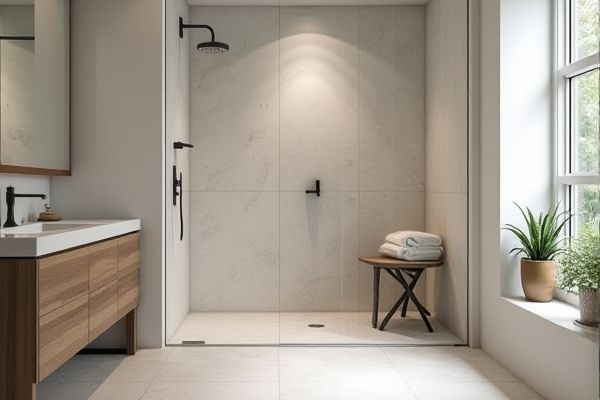
A shower bench offers more surface area and stability, making it ideal for those needing extra support and space for toiletries, while a shower stool is typically smaller, more portable, and suited for limited bathroom spaces or quick use. Discover which option best fits Your needs and enhances safety by reading the rest of this article.
Table of Comparison
| Feature | Shower Bench | Shower Stool |
|---|---|---|
| Design | Long and rectangular, supports sitting or lying | Compact, round or square, supports sitting only |
| Size | Larger, fits multiple users or more surface area | Smaller, designed for one user |
| Weight Capacity | Typically higher, up to 400 lbs or more | Varies, usually up to 300 lbs |
| Portability | Less portable, heavier and bulkier | More portable, lightweight and easy to move |
| Installation | May require wall mounting or placement in shower | Freestanding, no installation required |
| Best For | Users needing stable support and space | Users needing compact, flexible seating |
| Material | Water-resistant wood, plastic, or metal | Plastic, aluminum, or stainless steel |
| Price Range | $50 to $300 | $20 to $150 |
Introduction: Comparing Shower Benches and Shower Stools
Shower benches provide extended seating space and often feature backrests, making them ideal for increased comfort and accessibility in the shower. Shower stools offer compact, portable seating that is easy to move and store but typically lacks additional support features. Choosing between a shower bench and a shower stool depends on your specific needs for stability, comfort, and bathroom size.
Key Differences Between Shower Benches and Shower Stools
Shower benches provide a longer, more stable seating surface ideal for users needing additional support and space, while shower stools are typically smaller, more portable, and designed for quick, convenient seating. Benches often feature backrests and armrests for enhanced safety, making them suitable for those with limited mobility or balance issues. Your choice depends on the space available in your shower and whether you prioritize comfort and support or compactness and ease of movement.
Space and Size Considerations
Shower benches typically offer a longer surface area, making them ideal for users needing extra space for sitting or assistance while showering. Shower stools are more compact and portable, fitting easily into smaller shower stalls or bathrooms with limited space. Your choice between a bench or stool should consider available shower dimensions and your space requirements for comfort and safety.
Comfort and Ergonomics
A shower bench offers greater comfort and ergonomics by providing a larger seating surface that supports multiple sitting positions and allows easy movement. Shower stools are typically smaller and less supportive, making them less comfortable for prolonged use but more convenient in compact spaces. Ergonomically, benches often feature backrests and armrests, enhancing stability and reducing strain, whereas stools usually lack these elements.
Installation and Placement Options
Shower benches offer versatile installation options, including wall-mounted, fold-down, or freestanding models that can be securely anchored for added stability, making them ideal for various bathroom layouts. Shower stools, typically freestanding and lightweight, provide flexible placement without the need for permanent installation, allowing for easy repositioning or storage. Both options accommodate different user needs and bathroom sizes, but benches require more planning for proper mounting, whereas stools prioritize convenience and mobility.
Safety Features and Stability
Shower benches offer enhanced safety features with sturdy backrests and armrests, providing additional support and reducing the risk of slips and falls. Shower stools prioritize compact stability with non-slip rubber feet and lightweight frames, making them easy to maneuver and secure on wet surfaces. Your choice should depend on the level of support needed, with benches ideal for extended use and stools suited for quick, stable sitting.
Material and Durability Comparison
Shower benches often feature durable materials like teak, aluminum, or heavy-duty plastic designed to support more weight and provide extended stability, while shower stools typically use lightweight plastic or metal frames suited for occasional, portable use. Your choice between a bench and stool should consider the material's resistance to water, mold, and rust to ensure longevity in a damp shower environment. Teak benches offer natural water resistance and durability, whereas plastic stools may wear faster but provide easier maneuverability.
Accessibility for Seniors and Disabled Users
Shower benches provide enhanced stability and comfort with backrests and armrests, making them ideal for seniors and disabled users who require additional support during bathing. Shower stools offer a more compact and lightweight option, suited for users with limited mobility but who need less support. Your choice should consider the level of assistance needed to ensure safe and accessible bathing experiences.
Price Range and Budget Factors
Shower benches typically range from $70 to $250 due to their larger size and added features like backrests or storage, while shower stools are generally more affordable, costing between $30 and $100. Your budget should consider the intended use, with benches offering more support and space for those needing extra comfort, potentially justifying the higher price. Material quality, adjustability, and portability also influence the cost differences between these two options.
Which Is Best: Choosing Between a Shower Bench and a Shower Stool
A shower bench provides extended seating and surface area ideal for users needing stability and space for personal care items, whereas a shower stool offers a compact, lightweight option suitable for smaller showers and easy repositioning. Shower benches typically support higher weight capacities and enhance accessibility for individuals with mobility challenges, while stools prioritize portability and convenience. Selecting between the two depends on bathroom layout, user requirements for support and space, and durability needs.
 homyna.com
homyna.com